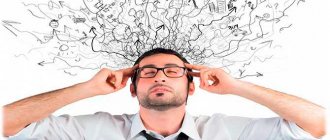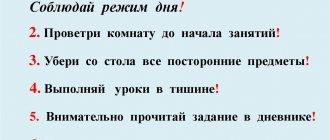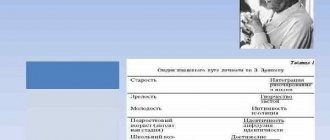Periods of formation of attention
Age-related features of the development of attention are one of the main topics in the study of human abilities. Undoubtedly, in the process of personality formation, attention goes through a certain evolution:
- The first few months of life - basic reflexes, spatial orientation, involuntary signs of attention. The child reacts to changes in the environment and external stimuli.
- The first year of a child’s life is learning about the world around him . He is increasingly interested in bright and new objects in the environment.
- The second and third years of life are the development of voluntary attention during the speech influence of adults.
- 4-5.5 years – the ability to concentrate develops under the influence of adults. At this age, it is useful to conduct training on switching or distributing attention.
- 5-6 years – independent focusing of attention, detailing and analysis of various objects appears.
- School age – improvement of volitional and voluntary types of attention. It is at school age that skills such as creating a clear and clear idea of tasks and their implementation are developed. Not only training observation skills, but also instilling discipline and responsibility, increasing the stability of attention while increasing the volume and complexity of the information offered.
- Upon reaching 18-20 years of age, changes in attention become more and more gradual. Verbal thinking and memory become more significant. This increases the connection of attention with the thought process.
Cultivating involuntary attention
In the education of involuntary attention in children, a prominent place is occupied by the formation of the ability to see and hear, observe facts and phenomena, and strive to become more fully and better acquainted with reality. To this end, the child must be introduced from an early age to the richness and diversity of the world around him, notice what is around him, and learn to respond to any change in the environment.
The learning process will be attractive for a child if he shows interest and emotions, which are the main condition for the appearance of involuntary attention. Of course, first of all, it depends on the material being studied, the way it is presented and the clarity of teaching. Involuntary attention is caused by the use of paintings, models, demonstration of experiments, the use of specific facts from life, etc. For younger schoolchildren, involuntary attention is simply necessary. Any visibility requires compliance with a number of conditions:
- Correctly organize the child’s perception;
- Set a specific task - answer a question, make a comparison, discover something new, etc.
- Learn to notice what needs attention.
Work organized with clarity activates the child’s thoughts, teaches him to be attentive, highlight the essential, and notice the main thing.
Involuntary attention is attracted by a qualitative explanation of the material being studied, bright in form, rich in content and emotionally rich. The presentation of any material should awaken thought, make you think about the questions that arise, and evoke a desire to find out what will happen next.
To attract and maintain attention, the activity of the children themselves is of great importance; it is important that they not only listen passively, but also act themselves - ask, answer, conduct experiments, etc. The general cultural level is also an important condition for attention.
Factors influencing attention
Age-related characteristics of attention are associated with the participation of various parts of the brain in thought processes. The effectiveness of the work performed depends largely on environmental factors.
Some objects are distracting. For example, bright colors, extraneous irritating sounds, emotional discomfort when communicating. At the same time, others help to concentrate. If it is, for example, silence or calm music, a discreet color scheme in the interior design.
However, being in a work environment for a long time also negatively affects concentration and ability to work. Therefore, it is worth taking small but regular breaks of 10-15 minutes. During this time, you can do some physical exercise. If possible, have time to drink tea or coffee.
Of course, fluctuations in the level of mental activity throughout the day are of great importance. As you know, scientists have proven that the highest efficiency is observed from 9.00 to 12.00 noon and from 15.00 to 19.00 in the evening. It is best to plan your working day taking into account these features.
Distribution as a property
Attention is characterized by five main properties: stability, concentration, switchability, distribution and volume.
Giphy
Let us dwell in more detail on the property of attention distribution. Have you ever done several things at the same time? If yes, then the principle of how attention is distributed is well known to you. The ability to hold several different objects or actions in the zone of active attention is called attention distribution.
Remember yourself at school: you were sure that you were in the field of view of the teacher, but your neighbor, or your deskmate, were also sure that the teacher was watching each of them personally. Proper distribution of attention is a professional trait of a teacher.
A good example of the distribution of attention is the driver of a car: the success of driving a car directly depends on the driver’s ability to maintain control in his zone, the attention of other road users, the technical performance of the car, and external environmental factors.
Exercises to develop attention
To improve concentration, there are various exercises and simulators. For example, they can be used on our interactive portal BrainApps, whose blog you are now reading. Their goal is to train the skill of focusing attention and concentrating only on the object of work. Here, for example, are a few simple exercises:
- Focus your gaze on the phalanx of one of the fingers, try to hold your attention for 2-3 minutes. But at the same time, do not be distracted by what is happening around you.
- Turn on an interesting movie or TV show on TV. Place your watch in front of you and watch the second hand, but don’t look at the screen.
- Turn on music, preferably dance music, close your eyes. After this, “listen” to your breathing or heartbeat.
- Before going to bed, take a sheet of printed text and draw a medium-sized green circle in the center. your attention for 5-7 minutes , and then try to fall asleep immediately.
- If possible, focus your attention on the sounds around you for 9-10 minutes.
- Try reading a book that doesn't interest you. At the same time, try to extract from it and comprehend at least some of the information that might interest you.
- When leaving home, pay attention to people who do not follow the rules of protection against the virus (masks, distancing), how many of them are there as a percentage of the total? Update this number after each person you see.
But you can develop attention during working hours. There are special exercises that allow you to train during breaks between work. For example:
- Before leaving your office, look around the room for 7-10 seconds. Then try to remember in detail the objects that came into your field of vision.
- Ask a colleague to type any twenty numbers. After that, try to find a sequence or relationship in them.
- Take a pencil or pen in both hands and try to draw a rhombus and a circle at the same time. If it doesn't work, repeat the procedure several times. This exercise helps develop motor skills and concentration.
Attention is a vector for energy
Attention directly interacts with such a concept as energy. “Where attention goes, energy comes” - this expression is often used in the practices of self-knowledge, marketing, trade, in any direction where the presence of a person is an important component of success. Presence is confirmed by the presence of energy, which in turn is provided by attention. This is the ouroboros serpent. In essence, managing attention is a struggle for the most valuable thing in this world: energy.
Attention in its focus is:
- external – direction to external objects of the environment;
- internal - focus on oneself, on one’s inner world.
Externally, concentration of attention can be expressed in mental, motor, and sensory processes. Examples of external manifestations of the direction of attention are postures of attention. They are different for external and internal attention. Remember yourself when something becomes very interesting to you. Your head turns, your gaze focuses on the object of interest, your breathing rhythm changes.
It is often said that “you listened with bated breath.” A completely different thing happens when your attention is focused inward: your eyes often close, or your gaze becomes wandering, focusing on nothing. The expression is appropriate here: “You’re in the clouds again.”
Feminine trait
The cognitive ability to distribute attention is an important quality for the effective implementation of assigned tasks in everyday life.
Image by Gerd Altmann from Pixabay
It is a known fact that women, by nature, are more prone to multitasking and have increased resistance to stress factors.
This has developed historically, and is due to feminine nature itself. At the everyday level, the distribution of attention has the form of proper planning of a sequence of processes: clearly determining the priority and sequence of goals, while taking into account the conditions and influence of external factors, can be considered an almost genetic, female trait.
The Downside of Distribution
If we look at any of the examples related to the distribution of attention in more detail, we can come to the conclusion that distribution is the reverse side of another property of attention, and this property is switchability. Switchability is the speed at which attention moves from one object to another. How are these two properties of attention interrelated?
Image by Gerd Altmann from Pixabay
The whole point of the relationship lies in the time interval, which is taken as a unit when considering the situation. The shorter the time period, the more obvious it becomes that, at this very moment, only one action is performed. The next action creates the illusion of simultaneity with the previous one, only thanks to the fast switching horse.
Edible, inedible
The speed of conscious switching of attention is a well-trained property of human attention. An example of an exercise for training switching speed is the children's game “Edible, Inedible.” The participants of the game sit in a circle. The presenter, in turn, throws the ball and names the objects. If the object is inedible, then the participant to whom the ball is thrown must not catch it, and, conversely, edible objects are caught. A successful participant takes the place of the presenter.
Thus, by training your switching speed, you increase your ability to distribute attention, that is, you increase your level of information processing in multitasking mode.
Mindfulness exercises for children 4-5 years old
Children of this age are able to concentrate on a task for 20 minutes. The amount of attention increases, the baby learns to distribute it correctly. Role-playing games, creative activities (drawing, modeling, appliqué), and performing household chores help develop attention. A 4-5 year old child can already follow the rules quite well and remember them, due to this the voluntariness of all mental processes, including attention, develops. Here are games that will help your baby become more attentive:
- "4 Elements". Give your child instructions: each of the 4 elements has its own movement. When you call the word, the baby must perform the correct movement. For example, water – arms out to the side, earth – arms down, air – arms up, fire – jump. You can come up with your own version of the game that will interest your child.
- “Heard - clap.” Call out different words and have your child listen carefully and clap their hands when they hear a word that belongs to a pre-selected category (such as animals or vegetables).
- Labyrinths. This task, beloved by all children, perfectly develops visual attention and thinking.
- "Confusion." The child must name who is depicted in the picture.
To avoid absent-mindedness and other attention disorders, do not overload your baby with too complex tasks.
Games and exercises for preschoolers 5-7 years old
In children of senior preschool age, the volume of attention and its stability significantly increase. By playing and being creative, they can independently plan their actions. Exercises to develop attention at this age should be based on previously acquired knowledge, skills and abilities (for example, counting, spatial orientation).
- “Repeat the pattern.” Using counting sticks or popsicle sticks, lay out a certain pattern (or a schematic image of something, a letter, a number) on the table. The child must repeat it.
- "Graphic dictation." On a checkered sheet of paper, the child must draw a pattern under dictation (for example, one cell to the left, then two cells up, three to the right, and so on).
- "Wimmelbooks." These are books with small detailed illustrations. Invite your child to find something in the picture or count the number of selected objects.
- "Color the circles." Draw ten identical circles on a piece of paper. Next, following the verbal instructions, the baby must color each circle: for example, the second circle on the right is yellow, the fifth from the left is green.
- "Look carefully." Invite your child to find as many given letters as possible on a newspaper or magazine sheet (for example, find all the letters A or M).
- "Schulte Tables". These are tables filled with numbers (from 1 to 10 or from 1 to 20) in a chaotic order. The child should try to find all the numbers in order as quickly as possible.











